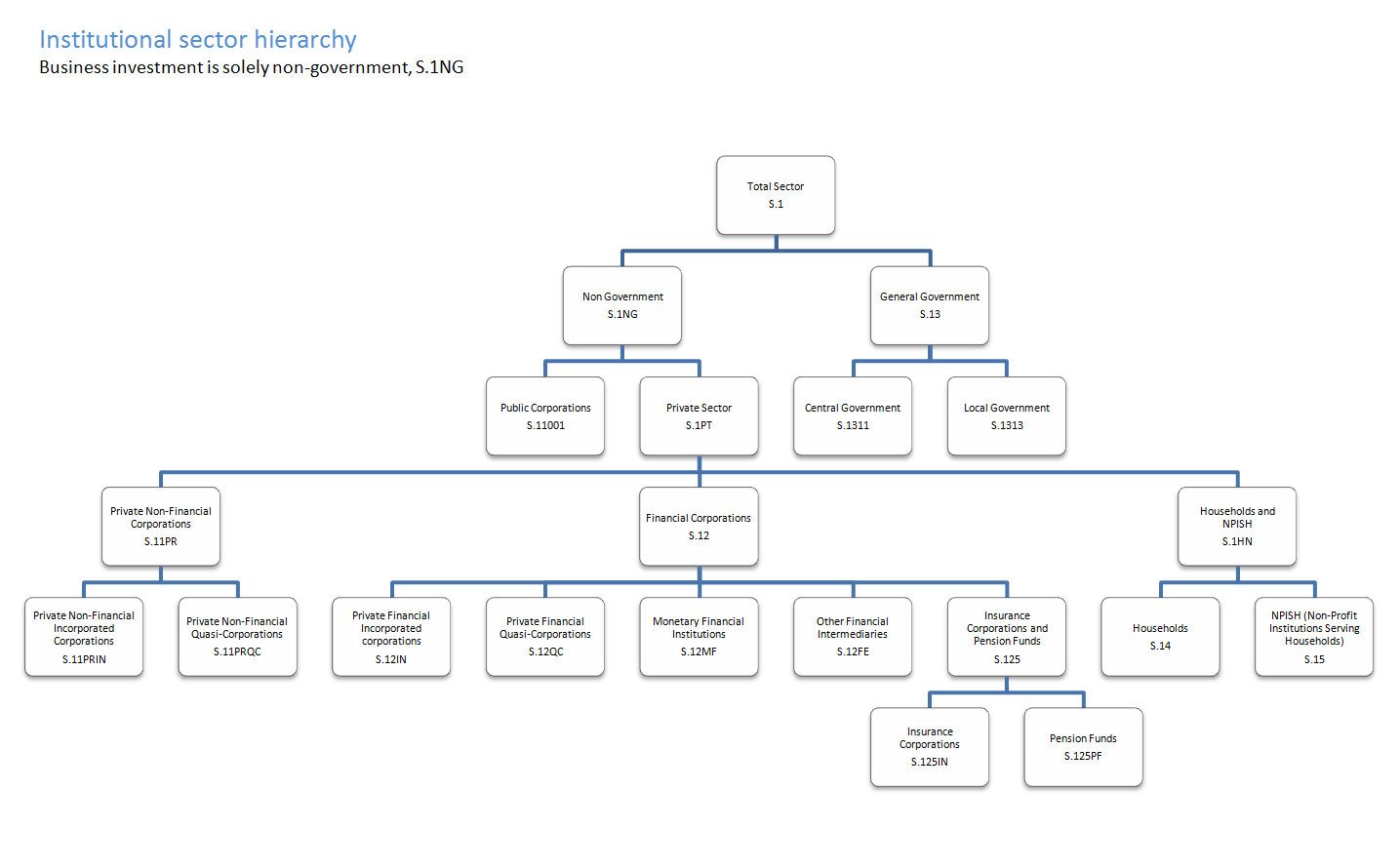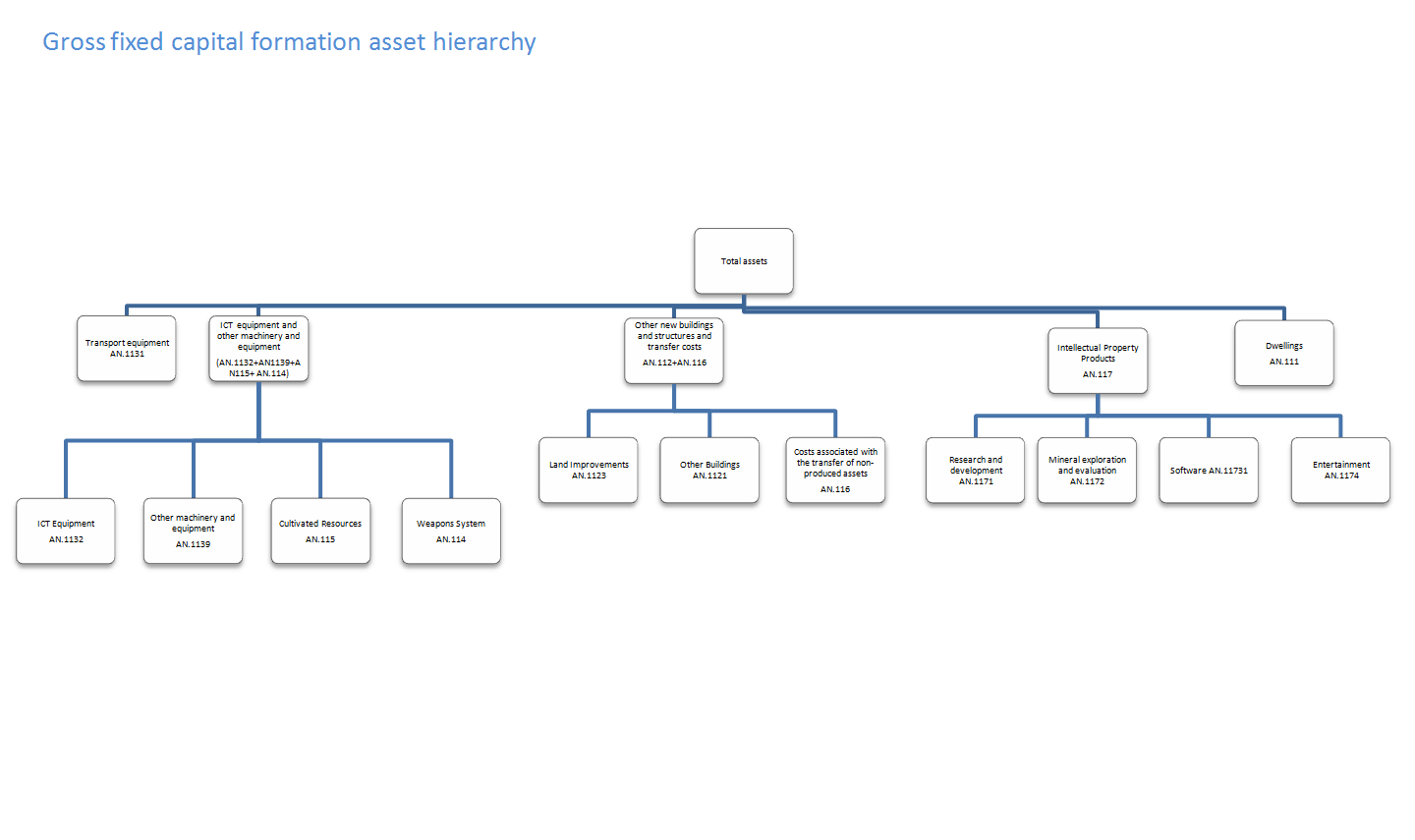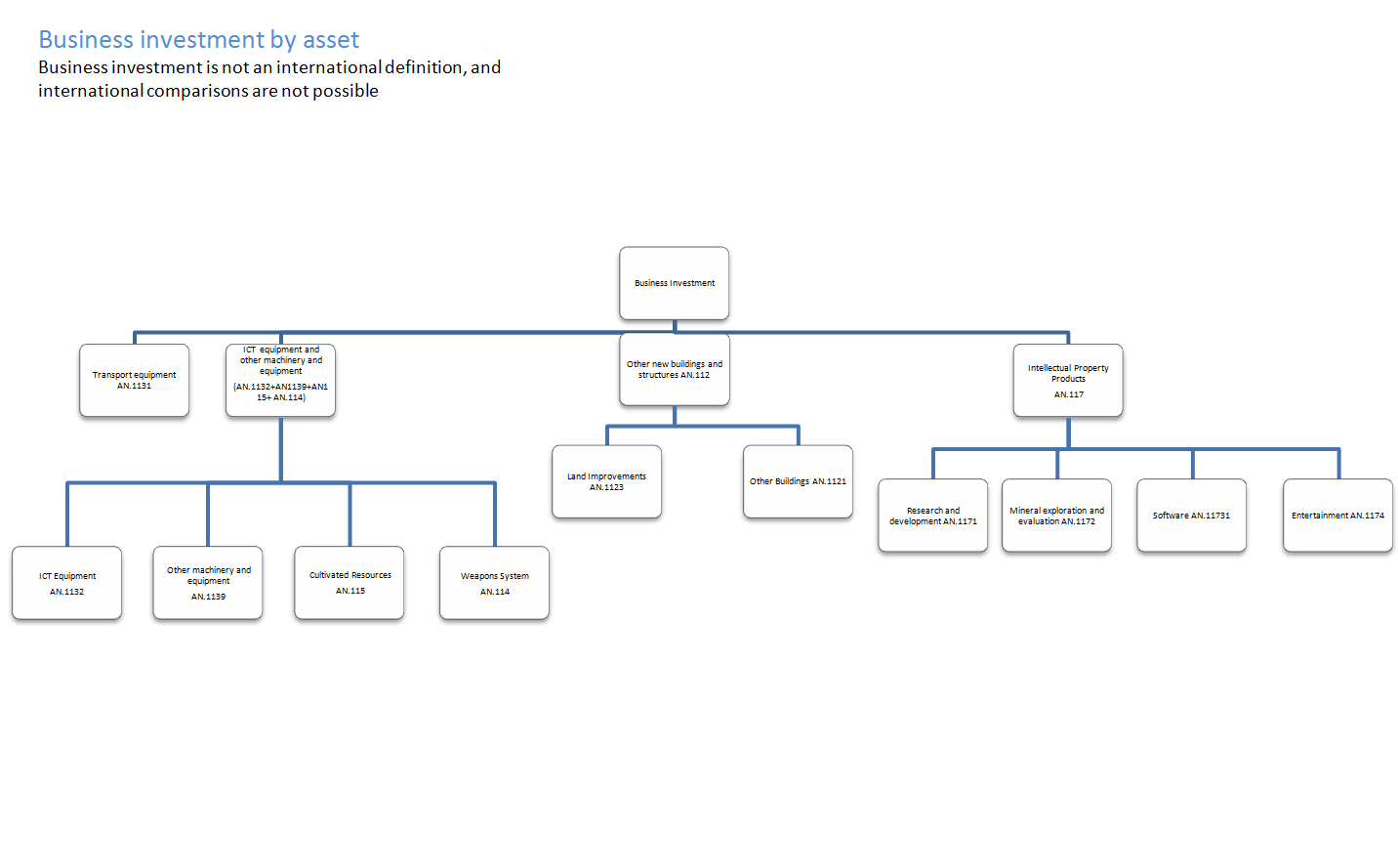Cynnwys
- Main points
- About this release
- Changes to the Quarterly Survey of Capital Expenditure and methodological information
- Gross fixed capital formation and business investment
- Summary tables
- Economic background
- Where to find more of our data
- Adjustments, revisions and response rates
- Background notes
- Methodoleg
1. Main points
Gross Fixed Capital Formation (GFCF) in volume terms was estimated to have fallen by 0.1% to £77.0 billion between Quarter 3 (July to Sept) 2015 and Quarter 4 (Oct to Dec) 2015.
Between Quarter 3 2015 and Quarter 4 2015, business investment in volume terms, was estimated to have decreased by 2.1% to £43.1 billion, a fall of £0.9 billion.
Between Quarter 4 2014 and Quarter 4 2015, GFCF was estimated to have increased by 2.7%.
Business investment was estimated to have increased by 2.4% between Quarter 4 2014 and Quarter 4 2015.
Business investment growth between 2014 and 2015 is estimated to be 4.7%, an increase of £7.9 billion.
The earliest period being revised in this release is Quarter 1 (Jan to Mar) 2015.
Nôl i'r tabl cynnwys2. About this release
The estimates in this release are short-term indicators of investment in non-financial assets in the UK, such as dwellings, transport equipment, machinery, buildings and intellectual property products. This release covers not only business investment, but asset and sector breakdowns of total gross fixed capital formation (GFCF), of which business investment is one component.
Business investment is net investment by private and public corporations, these include investments in:
- transport
- information, technology and communications (ICT) equipment
- other machinery and equipment
- cultivated assets
- intellectual property products (IPP, which includes investment in software, research and development, artistic originals and mineral exploration)
- buildings and other structures
It does not include investment by central or local government, investment in dwellings or the costs associated with the transfer of non-produced assets (such as land). A full sector and asset hierarchy can be found in the background notes. Note that business investment is not an internationally recognised concept and therefore it should not be used to make international comparisons.
All investment data referred to in this bulletin are estimates of seasonally adjusted chained volume measures.
Nôl i'r tabl cynnwys3. Changes to the Quarterly Survey of Capital Expenditure and methodological information
Changes to the Quarterly Survey of Capital Expenditure in Quarter 1 (Jan to Mar) 2015
As described in the Business Investment, Quarter 4 (Oct to Dec) 2014 Revised Results bulletin and in Changes to the Annual Business Survey, the Quarterly Survey of Capital Expenditure and the Survey into Business Spending on Capital Items, in 2015 (114.3 Kb Pdf), we moved to the Quarterly Acquisitions and Disposals of Capital Assets Survey (QCAS) from the Quarterly Survey of Capital Expenditure (CAPEX). The main reason was to move to the updated European System of Accounts (ESA) 2010 manual, the international guidance for national accounts.
The main changes to the survey are:
- adding new questions to improve the quality of our estimates and to meet the latest European legislation requirements (ESA 2010)
- removing the lower limit of £500 for the value of reported assets, so all relevant assets (even those below businesses’ Asset Register threshold) can be reported- including small tools used in production in the definition of GFCF
- improving the questionnaire’s layout, including new sections and headings, to make completing the questionnaire easier
The data from the new questions will not be included in estimates of GFCF and its components until 2017, when there will be 2 years of data available for quality assurance.
Further methodological information including changes to the UK National Accounts
On 24 February 2016 we published an article describing the impact on GDP current price annual estimates 1997-2011.
On 19 May 2015 we published several articles explaining the changes that were implemented in the UK National Accounts (Blue Book) 2015, published 30 October 2015. These articles describe changes related to ongoing work to meet ESA 1995 requirements. These include changes that impact GFCF and its components, specifically spending on repairs and maintenance of dwellings and exhaustiveness. There is a comprehensive list of all published articles relating to changes to the UK National Accounts (Blue Book).
Estimates in this release have been compiled under ESA 2010 concepts and definitions, in compliance with the UK’s legal obligations in producing the National Accounts. Articles are available describing the methodology used to estimate GFCF and the impact of the changes implemented for ESA10 in September 2014.
Nôl i'r tabl cynnwys4. Gross fixed capital formation and business investment
Figure 1: Annual gross fixed capital formation, chained volume measures
Reference year: 2012
Source: Office for National Statistics
Notes:
- The data in this chart covers 1997 to 2015.
Download this chart Figure 1: Annual gross fixed capital formation, chained volume measures
Image .csv .xls
Figure 2: Quarterly gross fixed capital formation, chained volume measures, seasonally adjusted
Reference year: 2012
Source: Office for National Statistics
Notes:
- Q1 = Quarter 1 (January to March), Q2 = Quarter 2 (April to June), Q3 = Quarter 3 (July to September), Q4 = Quarter 4 (October to December).
- The data in this chart covers Quarter 4 (October to December) 1997 to Quarter 4 (October to December) 2015.
Download this chart Figure 2: Quarterly gross fixed capital formation, chained volume measures, seasonally adjusted
Image .csv .xls
Figure 3: Annual business investment, chained volume measures
UK
Source: Office for National Statistics
Notes:
- The data in this chart covers 1997 to 2015.
Download this chart Figure 3: Annual business investment, chained volume measures
Image .csv .xls
Figure 4: Quarterly business investment, chained volume measures, seasonally adjusted
UK
Source: Office for National Statistics
Notes:
- Q1 refers to Quarter 1 (January to March), Q2 refers to Quarter 2 (April to June), Q3 refers to Quarter 3 (July to September), and Q4 refers to Quarter 4 (October to December).
Download this chart Figure 4: Quarterly business investment, chained volume measures, seasonally adjusted
Image .csv .xlsBusiness investment in Quarter 4 (Oct to Dec) 2015 has fallen by 2.1% to £43.1 billion when compared with Quarter 3 (July to Sept) 2015. This fall follows consecutive periods of growth (0.9% in Quarter 2 (Apr to June) 2015 and 1.2% in Quarter 3 (July to Sept) 2015) and takes business investment back to the level recorded in Quarter 1 (Jan to Mar) 2015. The fall in business investment has been driven by a larger volume of asset disposals compared with previous quarters, particularly in transport assets. It is the largest fall since Quarter 1 2014 (3.4%).
Annual business investment grew by 4.7% between 2014 and 2015, an increase in level of £7.9 billion. This is the largest £ billion increase since 2010 (£7.9 billion). The 2015 level of £173.7 billion is the highest on record.
Nôl i'r tabl cynnwys5. Summary tables
In Quarter 4 (Oct to Dec) 2015, total gross fixed capital formation decreased by an estimated 0.1% to £77.0 billion, compared with the previous quarter. Business investment decreased by 2.1%, falling by an estimated £0.9 billion. These decreases were partially offset by an increase in private sector dwellings of an estimated £0.4 billion (2.7%).
Table 1a: Total gross fixed capital formation in the UK by institutional sector, Quarter 4 (Oct to Dec) 2015
| % change | % change | £ million | £ million | |
| Most recent quarter on previous quarter | Most recent quarter on a year earlier | Most recent level ** | Level change from previous quarter | |
| Gross fixed capital formation | -0.1 | 2.7 | 77,043 | -43 |
| Business investment | -2.1 | 2.4 | 43,106 | -912 |
| General government | 1.5 | -1.3 | 11,714 | 170 |
| Public corporations dwellings | 4.6 | 18.3 | 1,074 | 47 |
| Public corporations cost of ownership | 1.9 | 8.6 | -165 | -3 |
| transfer on non-produced assets | ||||
| Private sector dwellings | 2.7 | 3.8 | 15,893 | 413 |
| Private sector cost of ownership | 4.7 | 9.4 | 5,421 | 242 |
| transfer on non-produced assets | ||||
| Source: Office for National Statistics | ||||
| Notes: | ||||
| 1. ** Series may not sum to totals due to rounding. | ||||
Download this table Table 1a: Total gross fixed capital formation in the UK by institutional sector, Quarter 4 (Oct to Dec) 2015
.xls (28.2 kB)In Quarter 4 (Oct to Dec) 2015, other buildings and structures and transfer costs saw the largest level decrease, falling by an estimated 3.0% to £23.8 billion. Transport equipment saw the second highest decrease, falling by an estimated 13.6% to £3.3 billion. These decreases were partially offset by an increase in dwellings of an estimated 3.7% to £17.2 billion.
Table 1b: Total gross fixed capital formation in the UK by asset, Quarter 4 (Oct to Dec) 2015
| % change | % change | £ million | £ million | |
| Most recent quarter on previous quarter | Most recent quarter on a year earlier | Most recent level ** | Level change from previous quarter | |
| Gross fixed capital formation | -0.1 | 2.7 | 77,043 | -43 |
| Transport equipment | -13.6 | 34.6 | 3,303 | -519 |
| ICT equipment and other machinery and equipment | 1.9 | 6.1 | 15,941 | 301 |
| Dwellings | 3.7 | 5.7 | 17,179 | 618 |
| Other buildings and structures and transfer costs | -3.0 | -3.1 | 23,807 | -729 |
| Intellectual property products | 1.7 | 0.9 | 16,813 | 286 |
| Source: Office for National Statistics | ||||
| Notes: | ||||
| 1. ** Series may not sum to totals due to rounding. | ||||
Download this table Table 1b: Total gross fixed capital formation in the UK by asset, Quarter 4 (Oct to Dec) 2015
.xls (27.6 kB)6. Economic background
Gross fixed capital formation (GFCF) increased by 2.7% in the final quarter (Oct to Dec) of 2015 when compared with the same quarter in 2014 and increased by 4.2% between 2014 and 2015. It remains higher than the pre-downturn annual average growth (Quarter 1 (Jan to Mar) 1998 to Quarter 4 (Oct to Dec) 2007) of 3.2%.
Business investment increased by 2.4% in Quarter 4 (Oct to Dec) 2015 when compared with the same quarter in 2014, the lowest growth rate since Quarter 2 (Apr to June) 2013. Business investment as a proportion of GDP fell by a quarter of a per cent to 9.6% in Quarter 4 2015. The Bank of England’s (BoE) Inflation Report points out the fall in investment in the oil extraction industry, which fell by around 20% between Quarter 2 (Apr to June) 2014 and Quarter 3 (July to Sept) 2015. This was due in part to the fall in oil prices. Despite the moderation in business investment growth towards the end of 2015, year on year business investment increased by 4.7% and is still significantly higher than the pre-downturn annual average growth of 2.5% (1998 to 2007). According to the BoE Inflation Report, one driver of this strength is continued growth in demand over the past few years and a consequent desire to increase capacity to fulfil it. The Agents' Summary of Business Conditions also points out that competition among banks has continued to lower the cost of corporate credit.
Nôl i'r tabl cynnwys7. Where to find more of our data
We also publish additional analyses of GFCF, business investment, and the Quarterly Acquisitions and Disposals of Capital Assets Survey, which have been created in response to ad hoc user requests. These are available to download free from our website. Enquiries about ad hoc requests may be made to gcf@ons.gov.uk.
Nôl i'r tabl cynnwys8. Adjustments, revisions and response rates
Adjustments
Large capital expenditure tends to be reported later in the data collection period than smaller expenditure. This means that larger expenditures are often included in the revised (month 3) results, but are not reported in time for the provisional (month 2) results, leading to a tendency towards upwards revisions in the later estimates for business investment and GFCF. Following investigation of the impact of this effect, from Quarter 3 (July to Sept) 2013, a bias adjustment was introduced to GFCF and its components in the provisional estimate.
A bias adjustment of £1.2 billion for Quarter 4 (Oct to Dec) 2015 has been included in this release. This adjustment will be reassessed in the revised results when the survey response rates improve. Users should note that the bias adjustment is a best estimate of the QCAS and the estimate may still be revised either up or down. Therefore, GFCF and business investment will be subject to revision in the Quarter 4 2015 revised (month 3) release. The bias adjustment is intended to reduce the average size of revisions over time. It is not possible to ascertain the direction of any such revisions.
The Quarterly Survey of Capital Expenditure has been improved by adding clearer instructions. As detailed in the provisional Quarter 1 (Jan to Mar) 2015 business investment release, feedback from some respondents indicated that they had been misreporting their asset breakdown and were correcting this on the new questionnaire. We found that some respondents were reporting new construction work (NCW) as other capital equipment (OCE). From Quarter 1 (Jan to Mar) 2015, respondents to the survey are now reporting more in new construction work at the expense of other capital equipment. In order to remain consistent with the previous data, we have made some adjustments to the assets in the current price series in Quarter 1, Quarter 2 (Apr to June) 2015 and Quarter 3 (July to Sept) 2015. These adjustments are outlined in Table 2.
Table 2: Adjustments made to buildings and other machinery to account for improved survey information, 2015
| Period | Adjustment to buildings (£ billion) | Adjustment to machinery (£ billion) | Revisions to buildings adjustment | Revisions to machinery adjustment |
| Q1 2015 | -1.5 | 1.5 | 0 | 0 |
| Q2 2015 | -2.1 | 2.1 | 0 | 0 |
| Q3 2015 | -1.9 | 1.9 | 0 | 0 |
| Q4 2015 | -2.6 | 2.6 | N/A | N/A |
| Source: Office for National Statistics | ||||
Download this table Table 2: Adjustments made to buildings and other machinery to account for improved survey information, 2015
.xls (26.6 kB)Revisions
Data in this release have been revised from Quarter 1 (Jan to Mar) 2015 to Quarter 3 (July to Sept) 2015.
The main reason for the revisions seen in this release is the impact on seasonal adjustment of adding the final quarter of the year – when the final quarter is added, the seasonal adjustment annual sum of the quarters is bench marked to equal the not seasonally adjusted annual total.
Revisions can be found in the datasets with this release.
Survey response rates
Table 3 presents the provisional (month 2, second estimate of GDP)) response rates for the Quarterly Acquisitions and Disposals of Capital Assets Survey (QCAS). The estimates in this release are based on the Quarter 4 (Oct to Dec) 2015 month 2 (provisional) survey results
Table 3: UK response rates for quarterly acquisitions and disposals of capital assets survey, 2014 to 2015
| At month 2 (Provisional) | At month 3 (Revised) | ||||
| Survey response rates / % | Survey response rates / % | ||||
| 2014 | Q4 | 80.1 | 2014 | Q4 | 94.4 |
| 2015 | Q1 | 67.3 | 2015 | Q1 | 88.8 |
| Q2 | 70.8 | Q2 | 88.5 | ||
| Q3 | 72.1 | Q3 | 84.1 | ||
| Q4 | 68.6 | ||||
| Source: Office for National Statistics | |||||
| Notes: | |||||
| 1. Q1 is Quarter 1 (Jan to Mar). | |||||
| 2. Q2 is Quarter 2 (Apr to June). | |||||
| 3. Q3 is Quarter 3 (July to Sept). | |||||
| 4. Q4 is Quarter 4 (Oct to Dec). | |||||




